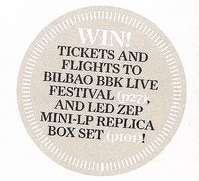
This is a contents page from an edition of Uncut magazine. A large amount of the space on this contents page is taken up by an editorial piece, this is unusual for the contents of a magazine, as the focus is usually large images and list of what is being featured in that month or week's issue. After researching more into this cover, and the style of Uncut magazine, I have found out that they ask their editor to write a piece for the contents page of each magazine that promotes bands with a similar music style to that of the featured band/artist of that month. This would allow a niche audience to be created as the section would appeal to fans of the featured band that are looking to find more artists creating a similar sounding music and also creates a convention for Uncut magazine to keep their editorial piece in each magazine.
This is something that appeals to me and is something I would like to include in my magazine as it allows readers to try a new type of music they may not have before and is helping to break down boundaries between different music genres, something I would love to achieve with my magazine.
The magazine has taken an approach to their layout that I do not like, there is a list of the main feature articles and then above that there is a small selection of images that are relating to some of the articles. The font sizes for the title of each article are all the same, along with the colour of each. Underneath, a summary of each article has been included and this is in a smaller font size and also in black rather than gold for the colour.
The heading for the section is in a red banner and the writing is in a white, block capital font. Both of these things allow the text to stand out and be easily red. The red makes the heading look more important, and also allows the red background of the review section next to it look brighter and more important than the other articles and draws the readers attention.
By including mostly black and white colours on the contents page, the use of the red background shows how important the article is and makes it a focus point of the page. By placing it next to the editors piece it allows those two sections to work together to make the information come across more arrogantly and separately to the remaining information on the page.

On this contents page, there are neutral coloured images which again reinforces the brightness of the red, and the calm colours make the imaged look sedate and cool, and the centre of the images contains the product placement of an album, perhaps one being given away with the magazine or as another article image about a new album. This is different to the rest of the group or live shot images and then is more noticeable on the contents between the images.
How this research has influenced my ideas and creativity:
Each time I analyse a contents page set up in this format and layout, it reinforces the fact that I would like to break the conventional vintage rock magazine layout and bring something to a more modern audience. I also like the use of the red to indicate something important as it is eye catching and also holds a symbolic sign of importance,












































